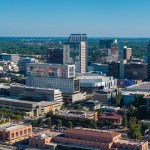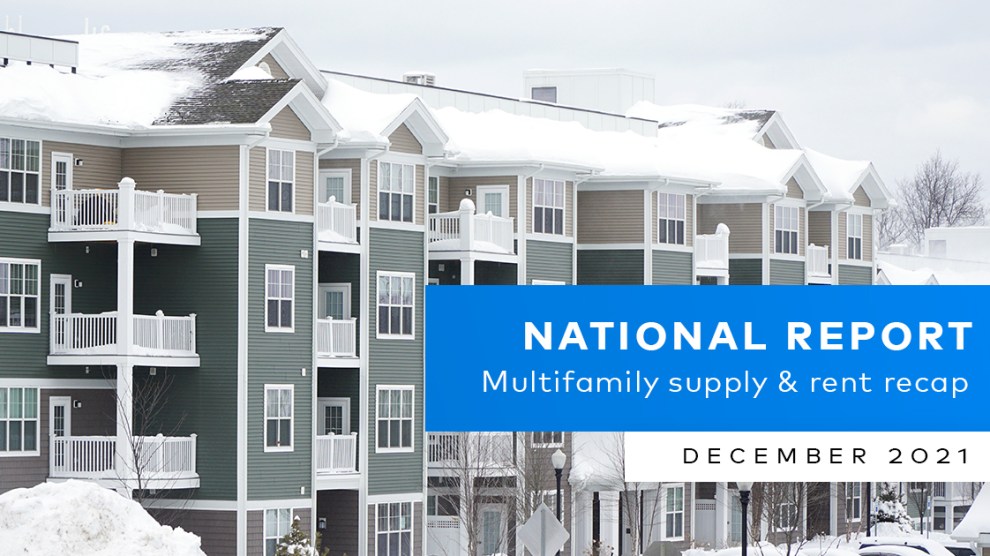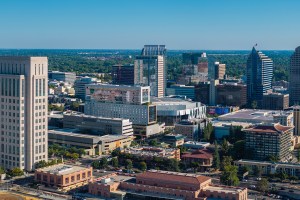Multifamily Rent Growth—A Normal Month Ending an Anything but Normal Year
The national multifamily market’s record year ended with a new record—the long-term rent growth is more than double any previous year, but the short-term rate matches the typical seasonal performance.
Report highlights
- National rents closed the year with a 13.5% year-over-year uptick; rent growth in 2021 was more than double any previous year recorded by Matrix.
- Occupancy remained high, maintaining the 96.1% rate in November; nearly 600,000 units absorbed through November, about 50% more than the previous annual high set in 2015.
- Single-family rentals had asking rents rise 13.8% in 2021, and the occupancy rate maintained the softening trend and rose 0.4% year-over-year through December.
- Rent growth is anticipated to decelerate in 2022 and hover around a 5% annual increase, which, by historical standards, signals another strong year for the multifamily sector.
Seasonal Softening Leaves Almost no Mark in the Market’s Performance—Rent Growth Rises, Occupancy Still Above 96%
December was a regular month in an irregular year—the national average rent added just $2 in December, which is half the November increase and well below the $23 month-over-month gain in October. However, national multifamily rents rose 13.5% year-over-year, is 8% higher than the market’s previous peak year of 2015. Overall, the average U.S. asking rent rose $190 in 2021, to $1,594 in December. Through November, nearly 600,000 units were absorbed, roughly 50% more than the previous annual high, set in 2015, according to Matrix data, keeping occupancy above the 96% mark for the fifth consecutive month.
Rent growth was even across the map, with 26 of the top 30 metros posting double-digit increases year-over-year through December, and six with gains of 20% or more: Phoenix (25.3%), Tampa (24.6%), Miami (23.5%), Orlando (22.7%), Las Vegas (22.2%) and Austin (20.9%). However, the impressive annual growth is attributed in part to the fact that, in 2020, rent growth was relatively flat. A special case is New York, where the asking rent turned positive in July after 14 consecutive months of negative movement and ended the year with a 14.2% year-over-year gain in December.
Short-Term Rent Changes Remind of Normal Performance
On a month-over-month basis, December rent growth was up just 0.1%, marking a 20-basis-point deceleration from November, which had already marked a 120-basis-point decrease from October. Lifestyle and Renter-by-Necessity improved in lockstep.
Despite the relatively flat rent growth from November to December, by metro the numbers varied widely: 18 of the top 30 posted rent increases, led by the Inland Empire (1.1%), New York and Charlotte (each 1,0%), while another six markets had rents rise by 0.5% or more. In a dozen metros rents decreased, with the weakest performance in Portland (-1.0%), Raleigh (-0.7%) and the Twin Cities and Washington, D.C. (both -0.6%). On a trailing three-month basis, no metro posted negative rent growth.
New Migration Patterns Impact Rent Growth (and) Forecasting
Following the atypical year 2021, forecasting rent growth is more of a gamble than ever before. However, new migration patterns reveal where demand is hot, hence where growth could intensify going forward.
High-cost gateway centers experienced out-migration, residents reorienting to more affordable and less dense metros in the South and Southwest. Specifically, between March 2020 and December 2021, asking rents exploded in Phoenix (31.1%), Tampa (28.5%), Las Vegas (28.2%), Atlanta (22.9%), Orlando (21.4%), Raleigh-Durham (20.7%) and Charlotte (20.6%). Similarly, secondary markets neighboring high-cost metros have benefitted from the influx of residents looking to relocate, as reflected in the rent growth in the Inland Empire (25.4%), Sacramento (20.2%), Orange County (18.3%), Baltimore (11.7%), Colorado Springs (14.7%), Northern New Jersey (8.9%) and Long Island (8.6%).
Former high performers of the multifamily market are now trailing the rest and post average rents below pre-pandemic levels: San Jose (-4.8%), San Francisco (-2.1%) and New York (-0.1%). Their performance is tightly related to office usage, which has declined considerably here. However, demand shows healthy signs of recovery as, in November, the annual occupancy rate in stabilized properties was up 3.2% in New York, 2.9% in Chicago, 2.5% in San Jose and 2.0% in San Francisco.
The SFR Sector Marked a Maturation Milestone, Ends the Year on a High-Note
The sector’s asking rent marked a slight deceleration, but still closed the year up 13.8% year-over-year through December. Meanwhile, occupancy was up 0.4% nationally, but with a spotty performance on a metro level.
Looking at the sector’s performance throughout the past decade, 2021 appears as the year the industry matured: Institutional investors placed billions of capital into the sector, which prompted banks to accept financing SFRs more comfortably.
Read the full Matrix Multifamily National Report-December 2021











Add Comment